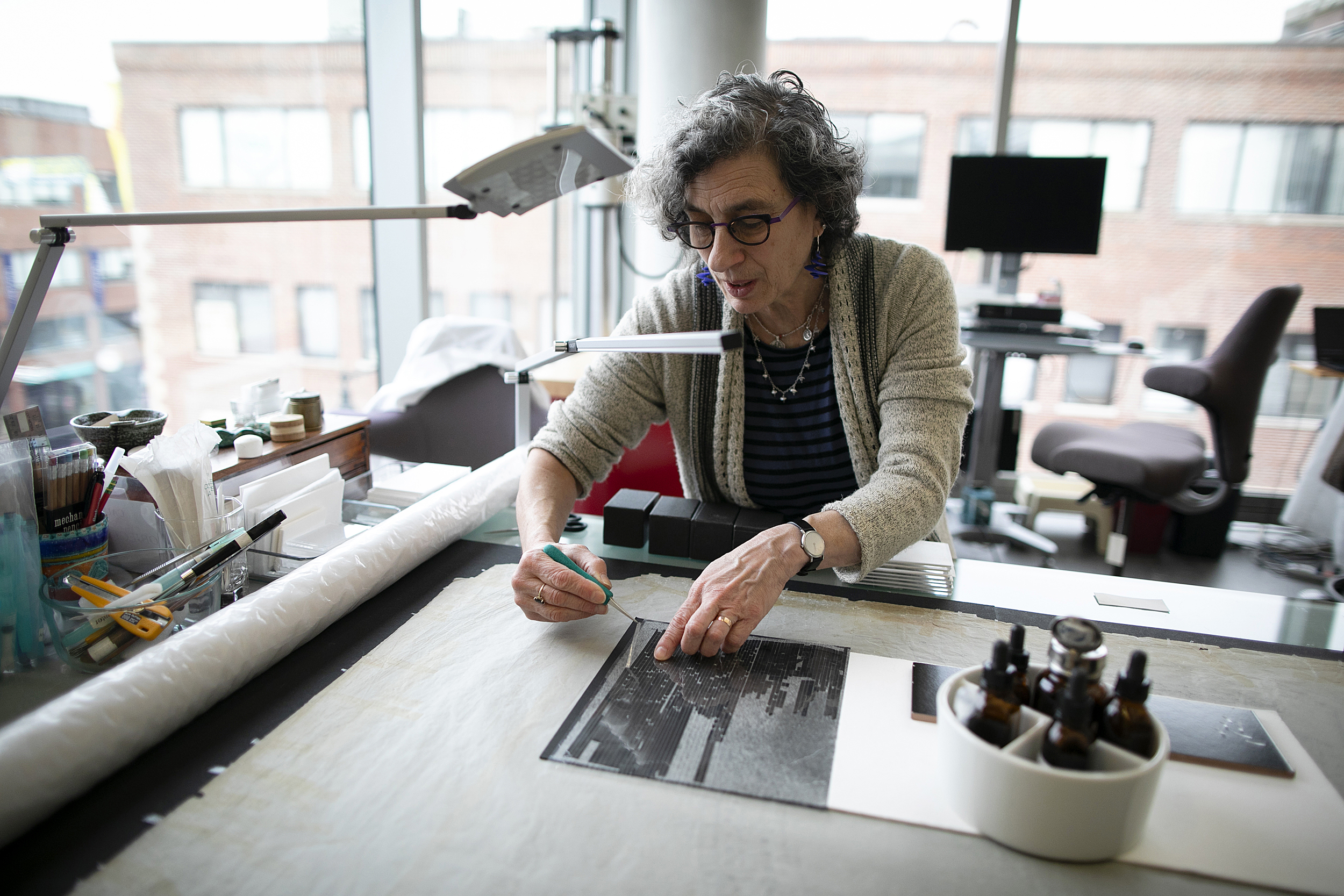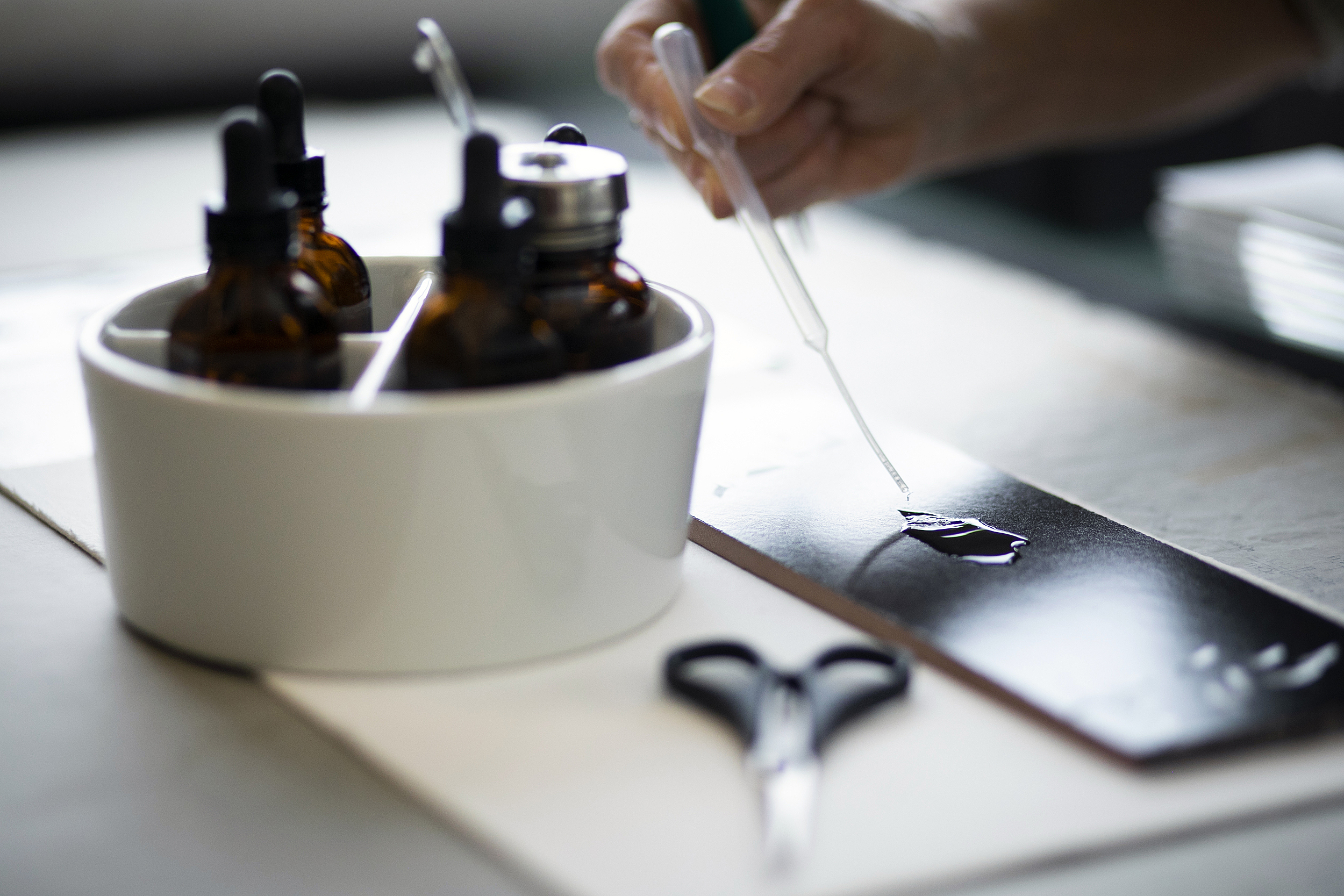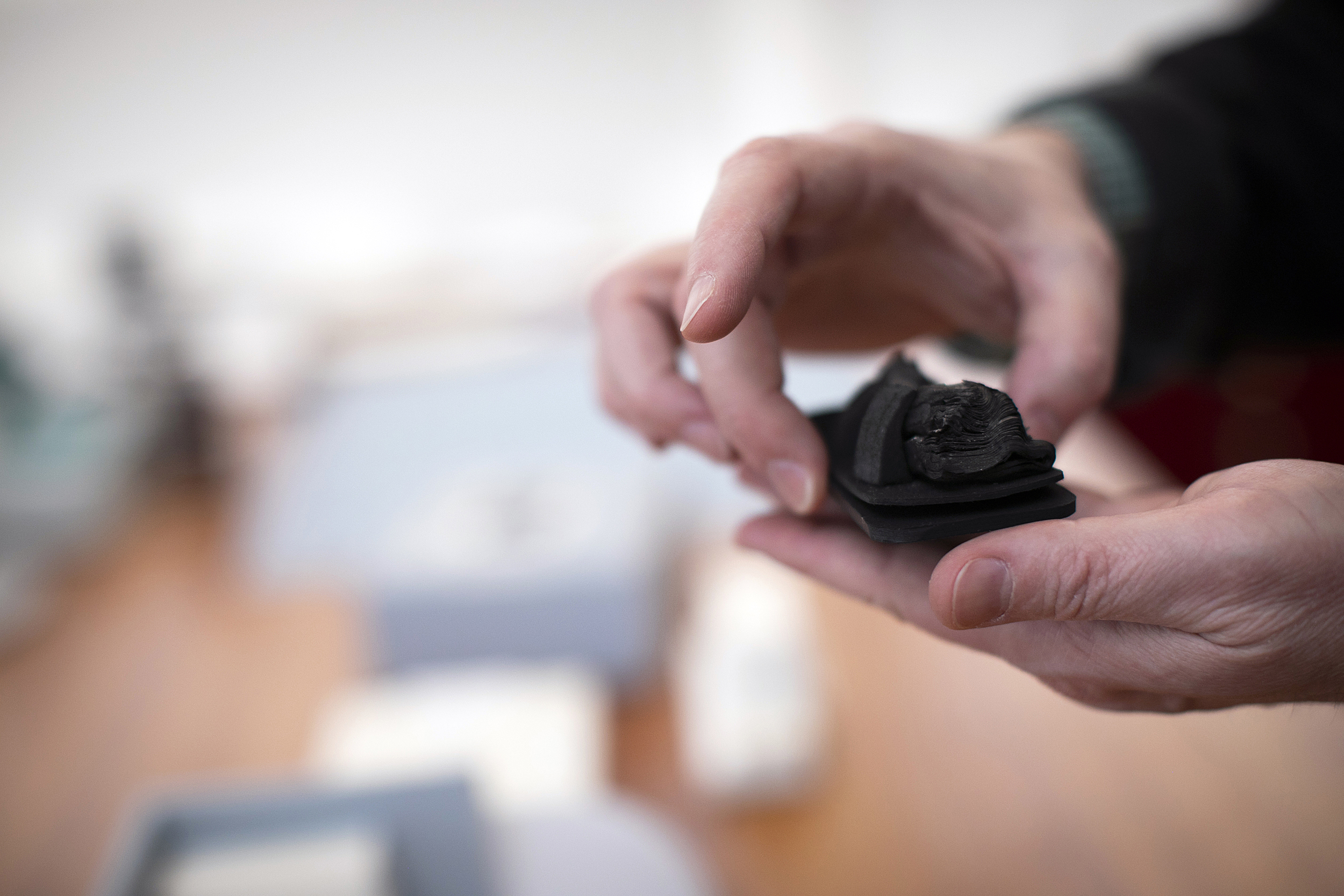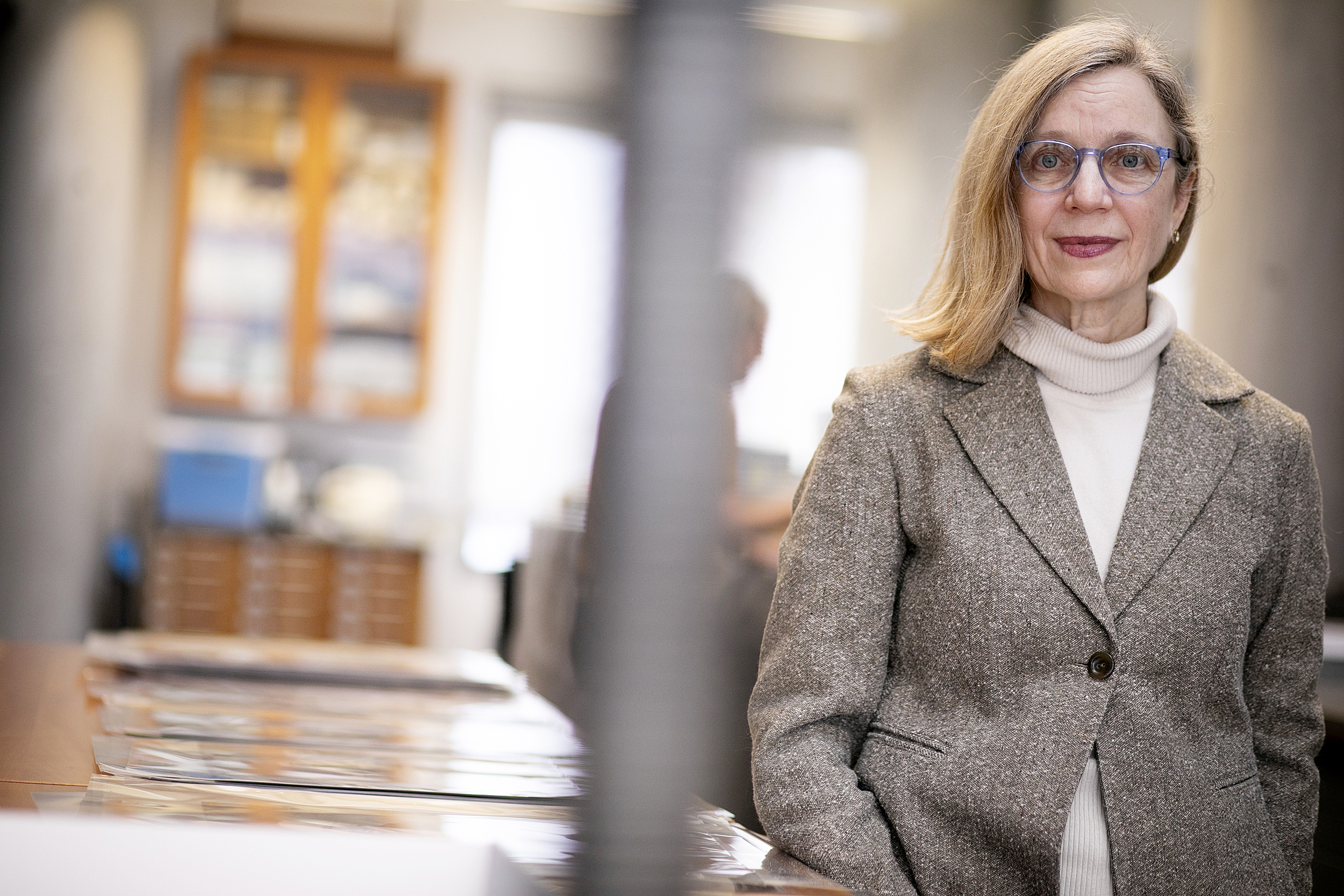
Helen H. Glaser Conservator Debora Mayer prepares collections for treatment using high-resolution, digitally scanned images, which are then entered into a database to preserve records of how and when items were treated.
Photos by Stephanie Mitchell/Harvard Staff Photographer
Preserving the future
Harvard’s Weissman Center focusing on its next 20 years
Twenty years ago, you might have found Debora Mayer at her worktable in Harvard’s campus center, bent over a fragile 17th-century drawing. She would be carefully marking a photocopy of the drawing, recording each place the original document had been repaired, and eventually moving on to the next item in a steady rhythm of independent work.
Mayer, who is now the Helen H. Glaser Senior Paper Conservator at the Weissman Preservation Center, works a bit differently today. She prepares collections for treatment using high-resolution, digitally scanned images, which are then entered into a database to preserve records of how and when items were treated.
But the key change is that seven other conservators are working with Mayer on her current project, which is unusual for many conservation labs but common for the Weissman Center.
“We work in teams; we have checks and balances,” Mayer said. “Our strength is that we’re a very collaborative lab.”
As the Weissman Preservation Center celebrates its 20th anniversary, Preservation Services Director and Malloy-Rabinowitz Preservation Librarian Brenda Bernier said the emphasis on collaborative problem-solving has been key to the center’s success.
Looking to the next 20 years, Bernier said, “That’s something I want to continue to foster and grow.”
The center was founded in March 2000 with a gift from Paul Weissman ’52 and his wife, Harriet. The Weissmans said the need for library funding resonated with them, as longtime benefactors of their local library who knew its importance as a cultural center.


Senior rare book conservator Alan Puglia said his most recent work involved preparing burned book fragments, some barely more than clumps of ash, to be shipped to London for display in a museum.
During the two decades since the center’s founding, staff have worked with hundreds of thousands of items from Harvard Library collections. They’ve prepared daguerreotypes for digitization, mended crumbling 14th-century land records, treated ceremonial swords to preserve the metal, and stabilized burned-book fragments to be loaned to the Imperial War Museums in London. They’ve also led training programs and workshops on handling, repairing, and displaying special collection materials.
As the Weissmans put it, center staff “work to preserve countless treasures for use by students, faculty, and researchers, now and in the days to come.”
“We feel privileged and honored to have our names associated with such a meaningful enterprise,” the couple added.
Vice President for the Harvard Library and University Librarian Martha Whitehead said the work of the Weissman Preservation Center is key to the vision she has been developing since joining Harvard last summer.

“Much of my vision for Harvard Library is focused on greater access and engagement with our collections, and preserving for the future. The conservators at the Weissman Center are central to this,” Whitehead explained. “Without the conservators’ understanding of how to properly treat items in the collections, we wouldn’t be able to digitize these items, share them with researchers, or teach with them in classrooms, now and for generations ahead. Our mission would be hampered greatly.”
A total of 18 staff members now work in the Weissman Center’s light-filled lab on Mount Auburn Street, which features cabinets of chemicals and protective goggles alongside paintbrushes and jars of paste. Books on the technical and historical aspects of preservation are stacked on shelves underneath large, custom-made worktables. The calm precision of the lab staff as they work belies the magnitude of their charge: Collectively, they are responsible for millions of items in special collections across Harvard.
“That’s where the power of programmatic thinking and collaborative thinking comes in,” Bernier said.
Erin Murphy, the James Needham Chief Conservator at the Weissman Center, said the library system model has enabled more preservation projects that cut across traditional library siloes.

For instance, photo projects curator Melissa Banta’s current project is to help prepare 10,000 salted-paper prints for digitization. The prints are held in 12 different repositories across Harvard, but they will be searchable in a single online database when the project is complete.
For Banta, who has worked in preservation at Harvard since 1992, working with curators across campus through the Weissman Center “has been fantastic,” she said. “It’s this bird’s-eye view that allows you to work with all these different repositories.”
The collaborative nature of the center is key to cross-disciplinary objects as well, Murphy said. One project might require expertise in both photos and bookbinding — which is not a problem when these experts sit only a few desks away from one another.
As the kinds of materials staff work with diversify, more projects fall under the “cross-disciplinary” category.
“We have a 20-year track record of adapting to change. Collectively, we’ve proven that we can do this, so I have a lot of confidence that we can take it to the next level.”
Erin Murphy, the James Needham Chief Conservator
Conservators still work with 400-year-old manuscripts, but they also work with photographs, textiles, plastic, digital prints, and even audio-visual materials. Banta has worked with photos on microfilm and CD-ROMs, while senior rare book conservator Alan Puglia said recent projects have included everything from marble to Scotch tape. His most recent work involved preparing burned book fragments, some barely more than clumps of ash, to be shipped to London for display in a museum. He sewed the remains of pages together with microfine thread and created foam supports to secure the fragile items during shipping.
Murphy said it’s becoming more and more common to hear things like, “Can I exhibit these plastic airplanes from the 1940s?” or “We have this wrought-iron candelabra, what do we do with it?”
The sheer number of items with which staff work continues to grow, as well. As more printed items are slated for digitization, Weissman Center staff are seeing a higher volume of requests like preparing a full manuscript to be scanned and made usable in digital form without damage.
As Murphy and Bernier look to the future, they anticipate a continuation of trends like preparing materials for digitization, especially as Harvard Library aims to make more of its collections freely available online. They also expect to see more requests to stabilize items for exhibition, like Puglia’s project for the Imperial War Museums.
Whatever Harvard’s future preservation needs turn out to be, Bernier and Murphy have the utmost confidence in the collaborative model of the Weissman Preservation Center.
“We have a 20-year track record of adapting to change,” Murphy said. “Collectively, we’ve proven that we can do this, so I have a lot of confidence that we can take it to the next level.”




